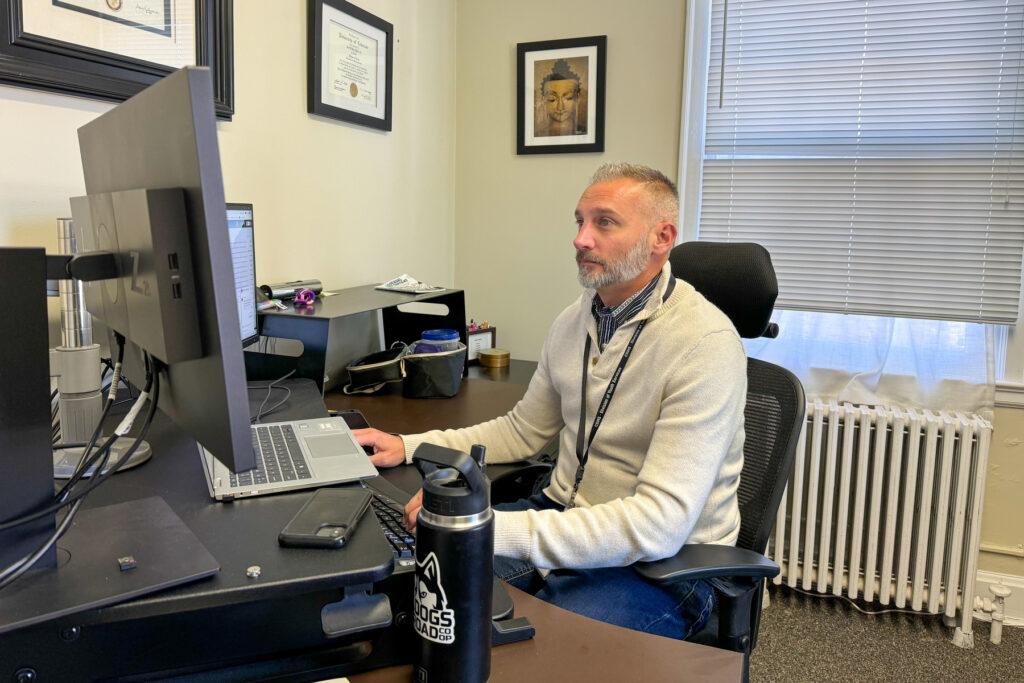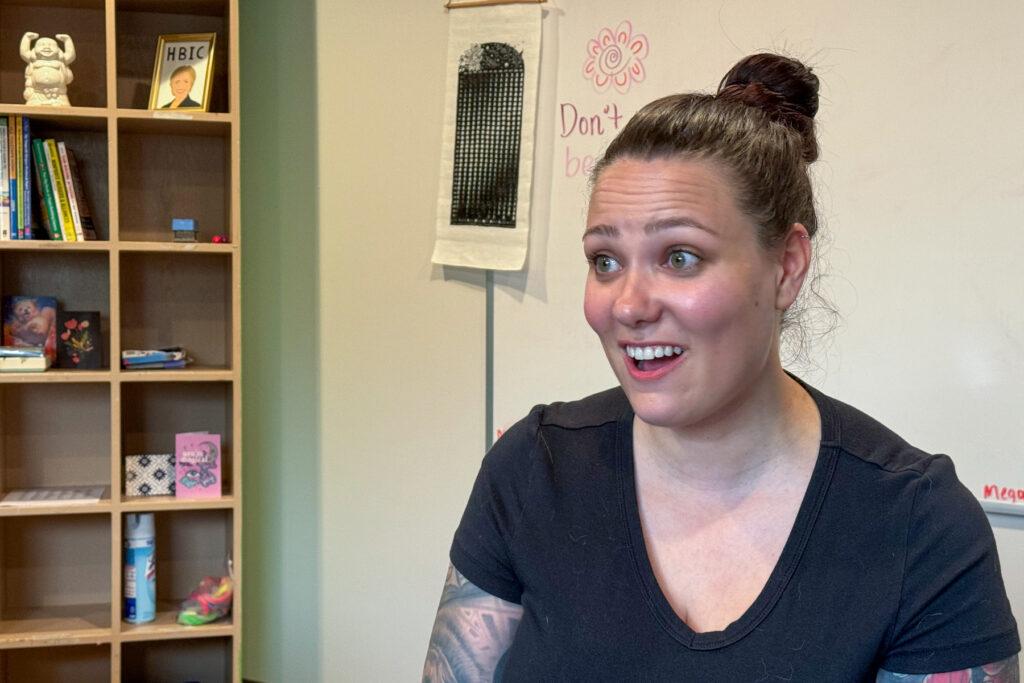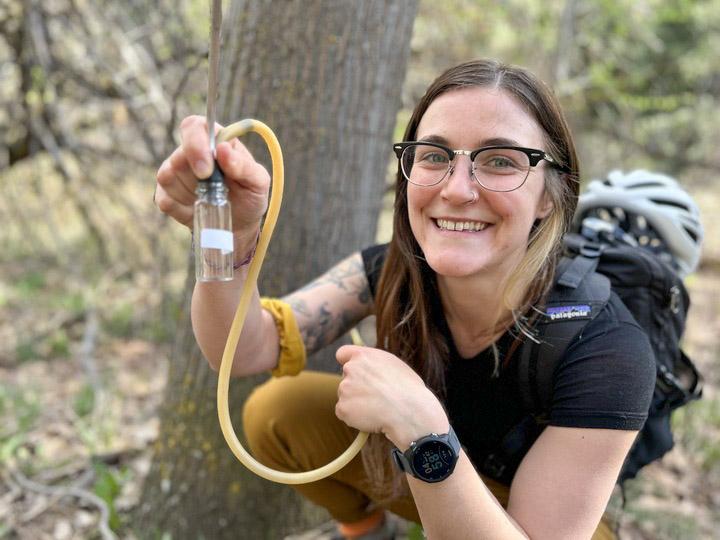
Editor’s note: This story was reported and written by CU NewsCorps. It was edited by CU and CPR News.
Hours from any big city, where the interstate carves through acres of prairie hills in northern Colorado, about 2,500 people are incarcerated at Sterling Correctional Facility.
Approximately 150 of them are convicted sex offenders who will have to complete treatment, managed by behavioral health providers like psychologists and social workers, to be released from prison. And they will have to continue treatment when they’re out.
But across the state, in facilities like the one in Sterling, Colorado’s Department of Corrections (CDOC) doesn’t have enough trained providers to treat the approximately 1,200 convicted sex offenders who are incarcerated and will be supervised for the rest of their lives.
Over the past 10 years, the number of filled behavioral health positions within CDOC has dropped by almost half – from about 75 percent in 2013 to just over 45 percent in August 2023.
Professionals working in the field worry that the lack of treatment providers could negatively affect public safety, recidivism, and the effectiveness of treatment itself.
The purpose of treatment, and what happens when it’s not available
People convicted of most classes of sex offenses in Colorado are required to complete behavioral health treatment to be paroled and as a condition of that parole once released.
Since 1998, the Sex Offender Lifetime Supervision Act has required the majority of adults who have committed offenses like rape, sexual assault, or most crimes involving children to be supervised for the rest of their lives, even if they’ve been released from prison.
Once incarcerated, sex offenders are managed under the Sex Offender Treatment and Management Program (SOTMP) within CDOC.
Throughout the treatment process, sex offenders are evaluated for their risk of reoffense, how intense the treatment needs to be, and their ability to respond to that treatment.
Therapists within the program hold group therapy sessions with offenders, focused on taking accountability for crimes, victim empathy, and reducing urges to commit future sex offenses.
As of August 2023, just 26 of the SOTMP’s 56 treatment provider positions were filled. It represents more than double the vacancies the CDOC had a decade ago.
When there aren’t enough providers, they have to take on extra work and are subject to increased caseloads. They are forced to prioritize the offenders who are most likely to cause harm in the future, according to Seth Wescott, a masters level psychologist who started working as a sex-offense treatment provider in Kansas prisons in 1997.
Wescott now runs a private practice and chairs the Association for the Treatment and Prevention of Sexual Abuse’s public policy committee.
“I've often said to clients that the treatment in the correctional facility is meant to prepare you for life on parole,” he said.
Wescott said staffing shortages in prisons make fewer resources available for the kind of maintenance-level treatment that helps ensure a person convicted of a sex crime doesn’t re-offend.
“When there are shortages of staff and appropriate treatment providers to implement services, that really strains the resources that are available and those clinicians spend a lot of time engaged in immediate risk reduction and immediate intervention strategies that take away from the clinical aspect of the work,” Wescott said.
“We are putting band-aids on situations rather than going in-depth with the clinical practices.”
Seth Wescott, chair of the Association for the Treatment and Prevention of Sexual Abuse’s public policy committee
Ashley Charbonneau, a Denver-based treatment provider who worked in the juvenile corrections system for five years, believes there could be larger public safety risks if prisons don’t have enough treatment providers.
“I think there are huge safety concerns,” she said. “And I think if we're not able to treat these clients with evidence-based interventions, then we're not reducing the chance of future victimization.”
CDOC declined to comment on what the consequences of a provider shortage on recidivism or public safety would be. A spokesperson said the quality of treatment in prison was not impacted by the staffing shortage.
What causes the shortage?
Even outside the prison system, Colorado has a shortage of licensed behavioral health providers who are approved to treat sex offenders. That number has fallen to 245 providers in 2022 from a high of 323 providers in 2019.
Finding people to work inside the prison walls is even more difficult.
CDOC did not allow reporters to interview sex offense-specific providers who are employed by the department. But according to other psychologists who work with sex offenders, the job of a behavioral health provider in a state prison is not attractive.
Isolation from urban or suburban population centers, lower pay in comparison to private practice, concerns over dangerous working conditions, and the alternative of remote work outside the state system are all reasons psychologists said these jobs aren’t attracting more applicants.
“Some of our CDOC facilities are pretty far outside of the metro area so those facilities have to recruit people who want to live in places like Cañon City, Buena Vista, or Sterling,” said Charbonneau.
She said being so far outside of a major metropolitan area “could be a barrier to getting people to work in some of the prisons."
Holly Carpenter, a treatment provider from Larimer County who runs her own private practice, agreed that the locations of state prisons make them unappealing to work in for younger providers. She said burnout and pandemic-era mental health challenges have taken their toll on the behavioral health profession as a whole.
“[The] shortage is because we've lost people … people went through their own stuff. People forget that mental health providers, therapists, are people with our own lives,” Carpenter said.
Charbonneau said working in a correctional facility comes with unique risks, which can impact professional staff.
“I think there's inherent fear and lack of safety,” Charbonneau said. “I've seen colleagues get assaulted, and that's traumatic as well.”
As with so many professions, the ability to work from home is an opportunity that many behavioral health providers find appealing, according to Carl Blake, the director of assessment and sex offense-specific services in Colorado’s juvenile correctional system.
“If you can work from home and set up a home office and be able to do teletherapy, you no longer have the overhead of an office space. You no longer run the risk of your clients having to travel and … suddenly you can work with clients all over the state,” Blake said.

Blake works for the Colorado Department of Human Services, which is separate from the CDOC and oversees all youth who are convicted of crimes.
There are significantly fewer youth convicted of sex offenses in juvenile correctional facilities, but Blake’s department also has a high vacancy rate. As of September 2023, 40 percent of the Division of Youth Services’s behavioral health positions were unfilled.
In response, Blake said providers have taken on larger caseloads, and administrators are stepping in to take cases, as well.
The impact of the provider shortage
It’s the job of Colorado’s Sex Offender Management Board (SOMB) to coordinate between state agencies, private practices, and law enforcement to treat sex offenders. In September 2023, board members discussed the severe shortage of therapists in Colorado prisons.
“They are really pulling double or triple duty,” said Kimberly Kline, chair of the SOMB.
Even double duty can’t make up for all the work that needs to be done, so treatment providers have been holding fewer group therapy sessions with sex offenders over the past several years.
According to data from CDOC, the quarterly average of SOTMP group sessions held per year dropped by about 30 percent between 2019 and 2022. That's a reduction of more than a thousand therapy sessions.
Another result of the provider shortage is that sex offenders may spend more time than necessary in taxpayer-funded prisons. Since successful completion of treatment is a requirement for many offenders to be paroled, delays in treatment may keep them in prison longer than they might otherwise be.
“The guys aren't getting any help that they could get, and it's not a good situation,” said Roger Kincade, who was convicted of sexual assault of a minor in 1999 and completed sex offender treatment while on probation. He’s now vice chairman of Advocates for Change, a group that works to improve conditions for sex offenders in and out of prison.
Not everyone on the board that manages sex offender treatment believes it should be robust while people are incarcerated, though. Denver Police Detective David Bourgeois, who’s a member of the SOMB, said treatment should happen only after someone has finished their sentence in prison.
“In my opinion, prison itself is not supposed to be rehabilitation. Prison is supposed to be punishment,” Bourgeois said.
But victims’ advocate Casey Ballinger, who’s also on the SOMB and works for a sexual violence prevention nonprofit, agrees with providers on the value of treatment in prison. Without it, Ballinger said, prison settings don’t always allow offenders the tools to take accountability for their actions.
Data from the SOMB shows 62 percent of inmates eligible for treatment were past their initial parole eligibility date as of data provided in September 2023, and unable to petition for release until completing treatment.

Carpenter, the private provider in Larimer County, believes more time spent in prison without getting help could hurt offenders’ capacity to be rehabilitated and avoid reoffending.
“They come out and tend to be more criminogenic, they tend to have more difficulty with authority [and] difficulties with socialization and blending back into the community,” Carpenter said.
That’s why she and others who work with sex offenders say treatment is an important tool for community safety.
According to a national study prepared by the Bureau of Justice Statistics in 2014, the rate of recidivism among sex offenders is somewhat lower compared to people released after serving a sentence for other crimes. About 67 percent of released sex offenders were arrested for any crime during the nine-year study, compared to about 84 percent of other released prisoners.
Colorado has some of the highest total recidivism rates in the country, according to a 2018 survey conducted by the Virginia Department of Corrections.
CDOC did not say if a shortage of treatment providers would impact recidivism rates.
“Pursuant to statute, lifetime supervision sentenced offenders are not released without first having been found by the Parole Board as an individual who has progressed in sex offense-specific treatment,” CDOC Public Information Officer Alondra Gonzalez-Garcia said in a statement.
She also said that the quality of SOTMP treatment is not impacted by the shortage of providers.
“The CDOC and community treatment providers are required to follow the treatment standards set by the SOMB. These care and quality standards are required to be maintained in all circumstances,” Gonzalez-Garcia said.

Solving the shortage
Charbonneau said she believes the state needs to offer more support for behavioral health staff.
“I think it's a recruitment and a retention issue,” Charbonneau said. She believes the state government and large private practices need to offer benefits like higher pay, and also “supervision, balance, flexibility and work-from-home options in order to retain the people that they're hiring.”
The Colorado Department of Corrections currently offers a $2,500 signing bonus for “qualified candidates.”
CDOC has taken other steps to improve retention among behavioral health providers. Prison-based employees have been given salary increases in recent years, and the department has purchased advertising on television, and online and made an effort to promote these jobs at recruiting events.
“We utilize multiple social media platforms to help engage and recruit potential candidates and we continue to seek ways to offer competitive pay to help attract and retain qualified candidates,” CDOC’s Gonzalez-Garcia said in a written statement.
Those efforts have yet to yield significant results.
But among providers who have continued to do this work for a long time, despite the sometimes comparatively poor conditions, there are common reasons they have stayed.
For Carpenter, Wescott, and others, the public service they perform is important enough to keep them in their jobs.
“Being in this field for 20 years, I hope that I’m only halfway done because I love this work,” Wescott said. “This is a field that is not stagnant. This is a field that is always growing, always trying to get better, always trying to evolve into something that brings us closer to a world without sexual violence.”
Editor's note: An earlier version of this story incorrectly described Kincade's supervisory status when he completed his treatment. Also, Kline's quote was misattributed to a different member of the Sex Offender Management Board. These errors have been corrected.








